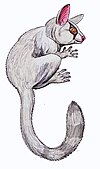Amphipithecidae
| Amphipithecidae Temporal range: Late Eocene to Early Oligocene
| |
|---|---|
| Scientific classification | |
| Domain: | Eukaryota |
| Kingdom: | Animalia |
| Phylum: | Chordata |
| Class: | Mammalia |
| Order: | Primates |
| Suborder: | Haplorhini |
| Infraorder: | Simiiformes |
| Family: | †Amphipithecidae Godinot, 1994 |
The Amphipithecidae were simian primates that lived in Late Eocene and Early Oligocene. Fossils have been found in Myanmar, Thailand, and Pakistan.[1] The limited fossil evidence is consistent with, but not exclusive to, arboreal quadrupedalism. In other words, the species may have moved about in trees on four legs, but not with regular leaping as seen in later simians.[2]
What little is known suggests that they are neither adapiform nor omomyid primates, two of the earliest primate groups to appear in the fossil record. Deep mandibles and mandibular molars with low, broad crowns suggest they are simians, a group that includes monkeys, apes, and humans, but are not within the two major extant groups of simians, the Catarrhini and Platyrrhini.[1] Most scholars place them in the simians.[3][4][5][6][7][8] However, some scholars suggest that their similarities to simians is the result of convergent evolution and that they should instead be considered Adapiformes.[1]
According to Beard et al., Siamopithecus is the most basal form of amphipithecid.[1]
They vary in size from 6–7 kg (Siamopithecus and Pondaungia), to 1–2 kg (Myanmarpithecus), with Bugtipithecus being even smaller.[9] A number of scholars speculate that the teeth and jaws of the larger Amphipithecidae indicate that they fed on seeds and fruit with hard exteriors, whilst smaller species such as Myanmarpithecus ate soft fruit.[10][2]
Pondaungia and Amphipithecus are now considered by scholars to be part of the same genus.[5][1]
Species
[edit]- Amphipithecus mogaungensis
- Bugtipithecus inexpectans
- Ganlea megacanina
- Myanmarpithecus yarshensis
- Pondaungia cotteri
- Siamopithecus eocaenus
Discoveries
[edit]When fossil hunter Barnum Brown was prospecting along areas of Pondaung Sandstone in Myanmar in 1923, he discovered a mandible with three teeth (Amphipithecus mogaungensis). He did not recognise the significance of his find until 14 years later, when Edwin H. Colbert identified the fossil as a new species of primate and the earliest known simian.[11]
In May 2005, the discovery of dozens of new primate fossils, mainly single teeth, in the Bugti Hills of Pakistan, was announced. They were recognised as belonging to three new species, including Bugtipithecus inexpectans, dated back to the Oligocene some 30 million years ago. (The other new species were in the Eosimiidae family).[9]
In July 2009, the discovery of Ganlea megacanina in the late-middle Eocene Pondaung Formation in central Myanmar was announced. It is smaller than Pondaungia, but larger than Myanmarpithecus. Its robust dentary includes a notably large lower canine tooth, but it had tiny incisors.[1]
References
[edit]- ^ a b c d e f Beard, K. Christopher; Marivaux, Laurent (July 2009). "A new primate from the Eocene Pondaung Formation of Myanmar and the monophyly of Burmese amphipithecids". Proceedings of the Royal Society B. 276 (1671): 3285–3294. doi:10.1098/rspb.2009.0836. PMC 2817178. PMID 19570790.
- ^ a b Kay, RF; Schmitt, D (January 2004). "The paleobiology of Amphipithecidae, South Asian late Eocene primates". Journal of Human Evolution. 46 (1): 3–25. doi:10.1016/j.jhevol.2003.09.009. PMID 14698683.
- ^ Chaimanee, Y.; Thein, T.; Ducrocq, S.; Soe, A. N.; Benammi, M.; Tun, T.; Lwin, T.; Wai, S.; Jaeger, J.-J. (2000). "A lower jaw of Pondaungia cotteri from the Late Middle Eocene Pondaung Formation (Myanmar) confirms its anthropoid status". Proceedings of the National Academy of Sciences. 97 (8): 4102–4105. Bibcode:2000PNAS...97.4102C. doi:10.1073/pnas.97.8.4102. PMC 18163. PMID 10760279.
- ^ Marivaux, L.; Chaimanee, Y.; Ducrocq, S.; Marandat, B.; Sudre, J.; Soe, A. N.; Tun, S. T.; Htoon, W.; Jaeger, J.-J. (2003). "The anthropoid status of a primate from the late middle Eocene Pondaung Formation (Central Myanmar): Tarsal evidence". Proceedings of the National Academy of Sciences. 100 (23): 13173–13178. Bibcode:2003PNAS..10013173M. doi:10.1073/pnas.2332542100. PMC 263736. PMID 14595009.
- ^ a b Jaeger, Jean-Jacques; Chaimanee, Yaowalak; Tafforeau, Paul; Ducrocq, Stéphane; Soe, Aung Naing; Marivaux, Laurent; Sudre, Jean; Tun, Soe Thura; Htoon, Wanna; Marandat, Bernard (2004). "Systematics and paleobiology of the anthropoid primate Pondaungia from the late Middle Eocene of Myanmar". Comptes Rendus Palevol. 3 (4): 243–255. doi:10.1016/j.crpv.2004.05.003.
- ^ Beard, K. Christopher; Marivaux, Laurent; Tun, Soe Thura; Soe, Aung Naing; Chaimanee, Yaowalak; Htoon, Wanna; Marandat, Bernard; Aung, Htun Htun; Jaeger, Jean-Jacques (2007). "New sivaladapid primates from the Eocene Pondaung Formation of Myanmar and the anthropoid status of Amphipithecidae". Bulletin of Carnegie Museum of Natural History. 39: 67. doi:10.2992/0145-9058(2007)39[67:NSPFTE]2.0.CO;2. ISSN 0145-9058. S2CID 85730138.
- ^ Bajpai, S.; Kay, R. F.; Williams, B. A.; Das, D. P.; Kapur, V. V.; Tiwari, B. N. (2008). "The oldest Asian record of Anthropoidea". Proceedings of the National Academy of Sciences. 105 (32): 11093–11098. Bibcode:2008PNAS..10511093B. doi:10.1073/pnas.0804159105. PMC 2516236. PMID 18685095.
- ^ Rose, Kenneth D.; Rana, Rajendra S.; Sahni, Ashok; Kumar, Kishor; Missiaen, Pieter; Singh, Lachham; Smith, Thierry (2009). "Early Eocene primates from Gujarat, India". Journal of Human Evolution. 56 (4): 366–404. doi:10.1016/j.jhevol.2009.01.008. PMID 19303624.
- ^ a b Marivaux, Laurent; Antoine, Pierre-Olivier; Baqri, Rafiqul Hassan Syed; Benammi, Mouloud; Chaimaneet, Yaowalak; Crochet, Jean-Yves; de Franceschi, Dario; Iqbal, Nayyer; Jaeger, Jean-Jacques; Metais††, Gregoire; Roohi, Ghazala; Welcomme, Jean-Loup (June 2005). "Anthropoid primates from the Oligocene of Pakistan (Bugti Hills): Data on early anthropoid evolution and biogeography". PNAS. 102 (24): 8436–41. Bibcode:2005PNAS..102.8436M. doi:10.1073/pnas.0503469102. PMC 1150860. PMID 15937103.
- ^ Ciochon, R. L.; Gunnell, G. F. (2004). "Eocene large-bodied primates of Myanmar and Thailand: morphological considerations and phylogenetic affinities". In Ross, C. F.; Kay, R. F. (eds.). Anthropoid origins: new visions. New York, NY: Kluwer. pp. 249–282. ISBN 9781461347002.
- ^ Ciochon, R. L. (1985). "Fossil ancestors of Burma". Natural History. 94 (10): 26.




